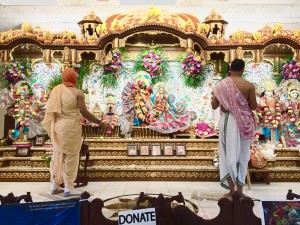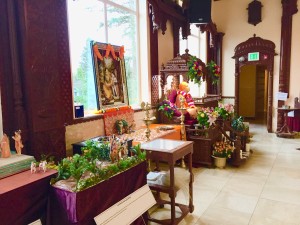Prayer is the universal language by which the human heart communes with the divine heart. Poetry is an artistic method for verbalizing the heart’s deep emotions. Singing is a popular method to express one’s emotions.
The integration of these three – prayers composed poetically and sung individually or collectively – is a powerful and joyful way to channelize human emotions towards the divine. In the world’s great theistic traditions are found many examples of beautiful prayer-songs. Such prayers are usually composed by saints who verbalize their love and longing for the Lord.
In the bhakti tradition, the singing of poetic prayers is an important limb of praxis. One such prayer-song is the Damodarashtakam found in the Padma Purana. The song is composed by the great sage Satyavrata Muni and sung in the presence of another great sage Narada Muni. In the Vaishnava bhakti tradition, during the sacred month of Kartik, this song is sung daily, often in both morning and evening. Singing the Damodarashtakam and offering a lamp to Lord Damodara is a treasured form of devotional service that attracts thousands the world over to come to Krishna temples.
The song’s title is a combination of two words: Damodara (a name of Krishna) and ashtaka (a composition with eight parts). This title reveals both the song’s theme and literary structure. It is about the Lord, whose belly (udara) was bound with a rope (dama) and who is therefore celebrated as Damodara. In literary structure, the song belongs to the genre of ashtakas. As the bhakti tradition considers the number eight auspicious, many prayers are composed as songs of eight stanzas.
Damodarashtakam is essentially a meditation on a Krishna pastime described in the bhakti texts, especially the Srimad Bhagavatam. The song integrates narration and exposition in a seamless poetic flow.
Verse 1: The uncatchable is caught
The song’s first verse begins with the mode of expression with which it ends: the offering of obeisance. The object of obeisance is predictably the Supreme, but he is referred to with a significant name: the controller (isvara). This pastime centers on the theme of how the supreme controller becomes controlled and still remains in control. It depicts a form of God that can seem to the devotionally uninformed diminutive and un-godlike. God is usually conceived and revered as the supreme ruler of all of existence. The bhakti tradition acknowledges this divine majesty, but focuses on a far more personable manifestation of God – as a loving and loveable cowherd who in his childhood play seems to be like an ordinary child. Lest hearers be misled by appearances, the song begins with an assertion of the protagonist’s divinity by identifying him as the controller. Further underscoring his transcendence, the song declares that his form is made of eternity-knowledge-bliss (sac-cid-ananda vigraha).
The verse conveys his beauty by referring to one of his ornaments: his effulgent earrings. Bhakti savants explain that whereas we humans wear ornaments to enhance our beauty, Krishna’s beauty is complete in itself, not needing any ornaments. When he wears ornaments, they don’t beautify him; to the contrary, he beautifies the ornaments. Thus, he is celebrated as the ornament of all ornaments (bhushanam bhushitah).
Among Krishna’s various ornaments, why are the earrings singled out for mention? The Vaishnava saint Santana Goswami explains in his illuminating commentary Dig-Darshini Tika that the earrings alone get to kiss Krishna. When he runs, the earrings move back and forth, thus getting to touch (and, poetically speaking, kiss) his cheeks. Another reference to kissing comes in the fifth verse. The metonymic use of the earring conveys not just the beauty of Krishna’s form but also the sublimity of the whole pastime.
After this philosophically and poetically pregnant introduction, the song orients us in space by mentioning the arena of the action: the effulgent Gokula (gokule bhrajamanam).
Having introduced us to the protagonist and the venue, the song starts describing the action. Krishna ran away in fear from his mother Yashoda, but was caught by the gopi (cowherd woman) who ran faster than him.
The backstory is that once when Krishna was sleeping, Yashoda was churning butter. Krishna woke up, went to her and started tugging her, conveying his hunger for her milk. She lovingly placed him on her lap and started breastfeeding him. While Krishna was feasting on the milk, suddenly Yashoda smelt and noticed that the milk on a nearby stove was spilling over. She hastily put aside Krishna and rushed to take the milk-pot off the stove. Krishna became indignant. His situation was like that of a person savoring a delicacy from a pot and suddenly finding that the pot had been whisked away.
Hungry and angry, Krishna looked around for some quick relief. He saw the butter pots his mother had been churning. Breaking them, he ate the butter. His hunger was somewhat mitigated, but his anger still remained. However, he also became apprehensive about being punished for his naughtiness in breaking the pots. So, he fled to another room where butter-pots were hung from the roof. Noticing that a grinding mortar was just below a pot, he climbed atop it, cracked open the pot and started eating more butter. The fragrance and noise attracted several monkeys from the vicinity. When they gestured, asking for the butter, Krishna gleefully shared it with them. While they were thus enjoying the butter, suddenly the monkeys’ mouths dropped open in alarm. Krishna whirled around and saw his mother creeping in on him. Panicking, he jumped off the mortar and fled.
In the meanwhile, Yashoda had returned to the churning room to find a mess. Krishna’s absence and the trail of his butter-marked footprints had been a giveaway of the mischief-maker’s identity and escape route. Following the trail, she had come to catch Krishna and discipline him.
The song presumes familiarity with the pastime, so it eschews a linear narrative and includes only narrative sections relevant to its exposition.
Krishna ran here and there to escape from Yashoda, but she managed to catch him because she ran faster than him. The Isopanisad (mantra 4) declares that the Supreme supersedes everyone in speed and can’t be approached even by the gods. Yet here he is not just approached but also caught by Yashoda. What enables her to achieve this astonishing feat will be revealed in the next verse.
Verse 2: Bound not by the rope’s length but by the devotion’s depth
The second verse begins with an activity extraordinary for the Supreme: crying. Crying is what we mortals do when afflicted by the world’s many miseries. And crying is what sometimes impels us to go to the Lord for relief. The Bhagavatam (3.28.32) states that meditating on the Lord’s beautiful smile can evaporate an ocean of tears. But here the one who relieves everyone’s tears is himself in tears. How is that to be understood?
The bhakti tradition explains that such tears are categorically different from our tears. The emotions underlying them are spiritual, not material. The transcendental realm is not devoid of emotions, but is permeated with pure spiritual emotions. The Lord of that realm, Krishna, is the supreme relisher of emotions and is celebrated as Rasaraja (the king of those who relish rasa, spiritual emotion). We too can enter that realm by purifying our emotions and directing them towards him. In fact, much of bhakti’s widespread appeal comes from its utilizing emotions as pathways to the divine.
This verse states that Krishna was sobbing and rubbing his eyes with his two lotus hands. The Bhagavatam (1.8.31) elaborates this scene, stating that he had lowered his head because of the fear that his mother would punish him. Here it is indicated he also stole glances at her with terror-filled eyes (satanka-netram). Due to his earlier running and present crying, his breath came out in heaves. The motion of his chest caused three lines to appear on his throat – lines that became visible when he looked up at his mother.
Beauty is often appreciated through certain universal characteristics. Additionally, different traditions have their own specific markers of beauty. In the Indian tradition, creases on the neck, when distinct and well-formed, are considered noteworthy signs of beauty.
The reference to his throat conveys that his handsomeness is innate to him. Unlike beauty through make-up that gets messed up when a person cries, Krishna’s beauty remains unaffected even when he cries.
The verse then condenses the action, mentioning only that Krishna was tied by his mother. The Bhagavatam describes how Yashoda struggled to tie him. She just couldn’t get the rope to go round his body – it remained short by a length equivalent to two fingers. She lengthened the cord by tying two ropes; still it remained two fingers short. No matter how many ropes she tied together, still the lengthened rope remained two fingers short.
Through this mysterious unspannability, Krishna conveyed his infinitude. He was in a tiny form that barely extended across the mortar to which he was being tied; still by his supremely mystical power he made it impossible for any rope to extend around him.
Bhakti commentators explain that the gap of two fingers can be filled, metaphorically speaking, by human endeavor and divine grace. Our endeavor can neither replace grace nor force grace to manifest. But by endeavoring in a devotional mood, we can attract divine grace. Yashoda wanted to tie Krishna not just because his mischievousness had angered her but also because she was lovingly concerned that his mischievousness would mar his prospects. While struggling in vain to tie Krishna, her mood changed from anger to appreciation of her son’s extraordinariness. As her disposition became increasingly devotional, Krishna became increasingly satisfied by the purity of her intention and the sincerity of her effort. So, he allowed himself to be tied. The song conveys that she succeeded in tying him not because of the rope’s length, but because of her devotion’s depth (bhakti-baddham).
The last line of this stanza contains the first of the three references to the title’s eponym, Damodara. The other two references come in the sixth and seventh texts.
The poetic refinement of this stanza is evident in its placing the most significant words at the start and at the end (rudantam and bhakti-baddham).
Verse 3: When sweetness supersedes greatness, love conquers the beloved
From the third verse, the song shifts from narration to exposition, dwelling on the significance of what has just happened. By such pastimes, Krishna inundates his devotees in a lake of bliss (ananda-kunda) and educates those attracted toward his majestic form that he is conquered only by intimate devotion.
God is both great and sweet. Awareness of his greatness evokes submission, whereas awareness of his sweetness evokes affection. Devotee-seekers need to be aware of both features, for submission and affection symbiotically reinforce devotion. But for exalted devotees such as Yashoda, their awareness of Krishna’s greatness is almost entirely eclipsed by their absorption in his sweetness. Yashoda is concerned not about how great Krishna is, but about how greatly he depends on her. If she doesn’t feed him, he will become weak and may even die. If she doesn’t invoke auspiciousness for him by her prayers, evil may befall him. If she doesn’t discipline him, he will become spoilt. Such intense love that is oblivious to his greatness is supremely endearing to Krishna – it enables him to relish the full gamut of reciprocal relationships. When his devotees are too aware of his greatness, that awareness inhibits their expression of love for him, thus limiting the range of possible loving reciprocations.
In this pastime, Krishna lets himself be tied, conveying that he is conquered by pure love. Thus, he encourages all devotees to rise in their God consciousness towards the level of unfettered love.
Meditating on Krishna’s loving nature, the poet Satyavrata Muni becomes overwhelmed by love and offers obeisance – not once, but hundreds of times.
Verse 4 – Love desires nothing other than the beloved
The song now addresses a theme common to most prayers – an appeal for benedictions. Satyavrata Muni acknowledges the Lord’s capacity to give benedictions by addressing him with two pertinent names: varam-deva (the giver of benedictions) and varesha (the Lord of benedictions). But he follows that acknowledgment by immediately refusing the benediction of liberation.
To appreciate the magnitude of this refusal, we need to understand the underlying worldview. People in general are materialistic and their materialism carries into their religion. So, when they approach God, they pray for various material things. The Vedas encourage such pious materialism as a stepping-stone towards pure spiritual love. The Vedic worldview is based on a tri-level cosmology with the earth occupying an intermediate level between the upper heavenly realms and the lower hellish realms. In the Vedic worldview, ascent to heavens is often considered the highest benediction. But Satyavrata Muni’s devotion is so exalted that the heavens are not even mentioned – even for the sake of rejection. In this context, any reference to heavens may be compared to the assertion, “Not even wrong!” used to discount an answer that is so far out of the ball-park as to not worth being dignified by being called wrong.
The Upanishads go beyond the pious materialism of the Vedas to a world-rejecting transcendence. In the Upanishadic worldview, liberation is often considered the ultimate attainment.
Satyavrata Muni’s rejection of liberation reflects his absorption in a reality beyond the impersonal Absolute. Is this reality God’s personal abode, Vaikuntha? No, for he also rejects the benediction higher than liberation, which Sanatana Goswami explains is the attainment of Vaikuntha. Then the sage refuses any other benediction that might be considered worthwhile. All this negation is the buildup to the climactic expression of his cherished aspiration: constant meditation on the Lord who has manifested in the form of a cowherd boy.
This aspiration is a riveting testimony to the purity of his love. In pure love, we desire our beloved more than anything else and turn away from anything that turns us away from the beloved. Here meditation on this love-filled Damodara pastime has triggered such a rapture of devotional ecstasy in the sage that nothing else holds any appeal. Thus, he desires to forever meditate on this supremely relishable pastime. Reiterating his aspiration, he concludes by asking rhetorically: What other benediction is desirable?
The post Meditating on the Damodarashtakam: The supreme controller is controlled – and still remains in control (Part 1 – Verses 1 to 4) appeared first on The Spiritual Scientist.






 By the GBC Strategic Planning Team
By the GBC Strategic Planning Team










 By Rsiraja Das
By Rsiraja Das


 By Giriraj Swami
By Giriraj Swami




 Srila Prabhupada departed from this world in Vrindavan dham, India, on the 14th of November 1977. One would not usually celebrate the disappearance day of a person, especially one so loved and revered as Srila Prabhupada. However, the departure of a pure Vaishnava gives cause for jubilation because he returns to his eternal service at Krishna's lotus feet in Goloka Vrindavan, the spiritual world. "He reasons ill who says that Vaisnavas die, When thou art living still in sound! The Vaishnavas die to live, and living try To spread the holy name around." (Srila Bhaktivinode Thakur) Although Srila Prabhupada is no longer physically with us, on the spiritual platform he is very much present. He is present in his deity form, in his books and through his instructions. His mercy is available to all those who seek it.
Srila Prabhupada departed from this world in Vrindavan dham, India, on the 14th of November 1977. One would not usually celebrate the disappearance day of a person, especially one so loved and revered as Srila Prabhupada. However, the departure of a pure Vaishnava gives cause for jubilation because he returns to his eternal service at Krishna's lotus feet in Goloka Vrindavan, the spiritual world. "He reasons ill who says that Vaisnavas die, When thou art living still in sound! The Vaishnavas die to live, and living try To spread the holy name around." (Srila Bhaktivinode Thakur) Although Srila Prabhupada is no longer physically with us, on the spiritual platform he is very much present. He is present in his deity form, in his books and through his instructions. His mercy is available to all those who seek it.

